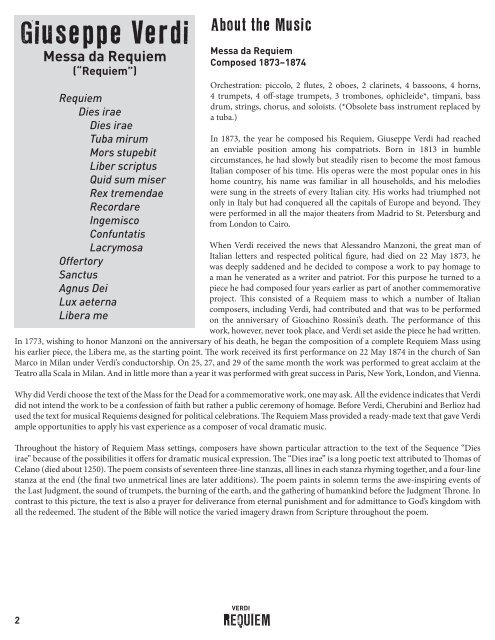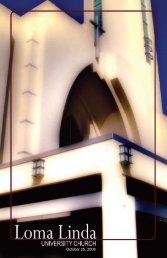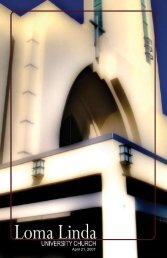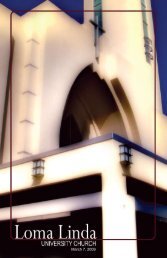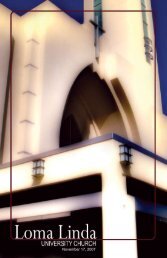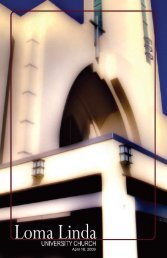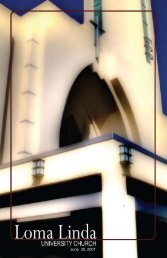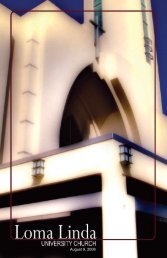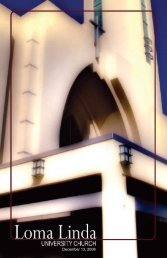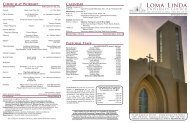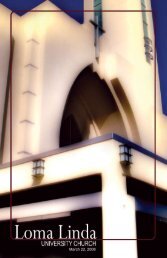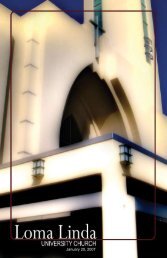LLUC Verdi Requiem Concert Program - Loma Linda University ...
LLUC Verdi Requiem Concert Program - Loma Linda University ...
LLUC Verdi Requiem Concert Program - Loma Linda University ...
- No tags were found...
Create successful ePaper yourself
Turn your PDF publications into a flip-book with our unique Google optimized e-Paper software.
Giuseppe <strong>Verdi</strong><br />
Messa da <strong>Requiem</strong><br />
(“<strong>Requiem</strong>”)<br />
<strong>Requiem</strong><br />
Dies irae<br />
Dies irae<br />
Tuba mirum<br />
Mors stupebit<br />
Liber scriptus<br />
Quid sum miser<br />
Rex tremendae<br />
Recordare<br />
Ingemisco<br />
Confuntatis<br />
Lacrymosa<br />
Offertory<br />
Sanctus<br />
Agnus Dei<br />
Lux aeterna<br />
Libera me<br />
About the Music<br />
Messa da <strong>Requiem</strong><br />
Composed 1873–1874<br />
Orchestration: piccolo, 2 flutes, 2 oboes, 2 clarinets, 4 bassoons, 4 horns,<br />
4 trumpets, 4 off-stage trumpets, 3 trombones, ophicleide*, timpani, bass<br />
drum, strings, chorus, and soloists. (*Obsolete bass instrument replaced by<br />
a tuba.)<br />
In 1873, the year he composed his <strong>Requiem</strong>, Giuseppe <strong>Verdi</strong> had reached<br />
an enviable position among his compatriots. Born in 1813 in humble<br />
circumstances, he had slowly but steadily risen to become the most famous<br />
Italian composer of his time. His operas were the most popular ones in his<br />
home country, his name was familiar in all households, and his melodies<br />
were sung in the streets of every Italian city. His works had triumphed not<br />
only in Italy but had conquered all the capitals of Europe and beyond. They<br />
were performed in all the major theaters from Madrid to St. Petersburg and<br />
from London to Cairo.<br />
When <strong>Verdi</strong> received the news that Alessandro Manzoni, the great man of<br />
Italian letters and respected political figure, had died on 22 May 1873, he<br />
was deeply saddened and he decided to compose a work to pay homage to<br />
a man he venerated as a writer and patriot. For this purpose he turned to a<br />
piece he had composed four years earlier as part of another commemorative<br />
project. This consisted of a <strong>Requiem</strong> mass to which a number of Italian<br />
composers, including <strong>Verdi</strong>, had contributed and that was to be performed<br />
on the anniversary of Gioachino Rossini’s death. The performance of this<br />
work, however, never took place, and <strong>Verdi</strong> set aside the piece he had written.<br />
In 1773, wishing to honor Manzoni on the anniversary of his death, he began the composition of a complete <strong>Requiem</strong> Mass using<br />
his earlier piece, the Libera me, as the starting point. The work received its first performance on 22 May 1874 in the church of San<br />
Marco in Milan under <strong>Verdi</strong>’s conductorship. On 25, 27, and 29 of the same month the work was performed to great acclaim at the<br />
Teatro alla Scala in Milan. And in little more than a year it was performed with great success in Paris, New York, London, and Vienna.<br />
Why did <strong>Verdi</strong> choose the text of the Mass for the Dead for a commemorative work, one may ask. All the evidence indicates that <strong>Verdi</strong><br />
did not intend the work to be a confession of faith but rather a public ceremony of homage. Before <strong>Verdi</strong>, Cherubini and Berlioz had<br />
used the text for musical <strong>Requiem</strong>s designed for political celebrations. The <strong>Requiem</strong> Mass provided a ready-made text that gave <strong>Verdi</strong><br />
ample opportunities to apply his vast experience as a composer of vocal dramatic music.<br />
Throughout the history of <strong>Requiem</strong> Mass settings, composers have shown particular attraction to the text of the Sequence “Dies<br />
irae” because of the possibilities it offers for dramatic musical expression. The “Dies irae” is a long poetic text attributed to Thomas of<br />
Celano (died about 1250). The poem consists of seventeen three-line stanzas, all lines in each stanza rhyming together, and a four-line<br />
stanza at the end (the final two unmetrical lines are later additions). The poem paints in solemn terms the awe-inspiring events of<br />
the Last Judgment, the sound of trumpets, the burning of the earth, and the gathering of humankind before the Judgment Throne. In<br />
contrast to this picture, the text is also a prayer for deliverance from eternal punishment and for admittance to God’s kingdom with<br />
all the redeemed. The student of the Bible will notice the varied imagery drawn from Scripture throughout the poem.<br />
2<br />
VERDI<br />
REQUIEM


